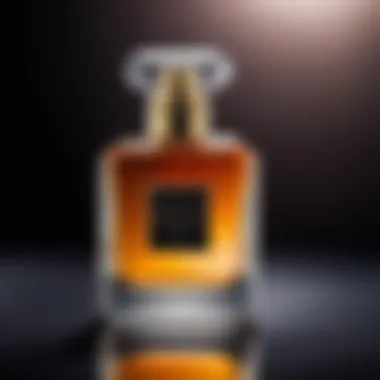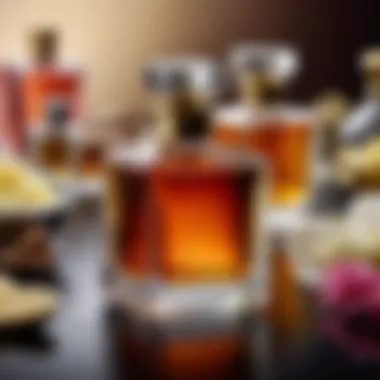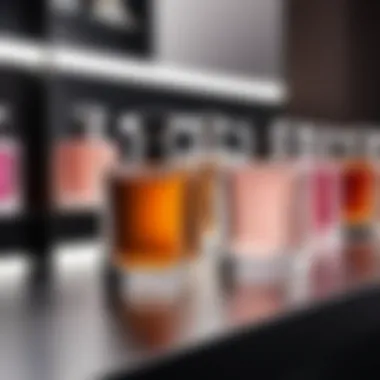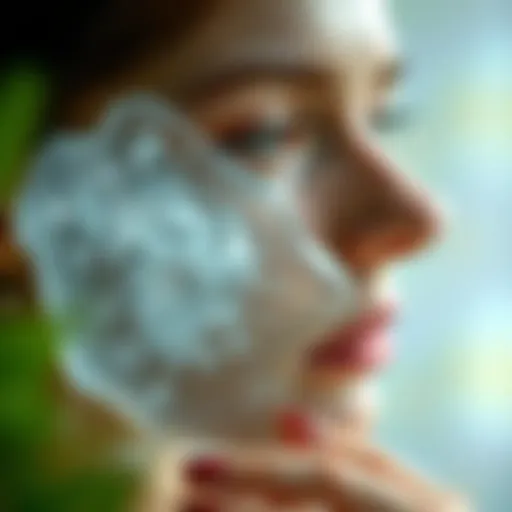Understanding Extrait de Parfum: A Comprehensive Guide


Intro
Fragrance is a significant part of personal expression and cultural identity. At the forefront of this realm is extrait de parfum, a rich and concentrated form of fragrance cherished by enthusiasts and connoisseurs alike. This article will explore the characteristics, historical context, and nuances that separate extrait de parfum from other fragrances. We will outline its components, applications, and factors driving its appeal in today's market. A blend of tradition and modernity, extrait de parfum remains a potent symbol of sophistication and allure.
Popular Promotions and Offers
When it comes to purchasing extrait de parfum, understanding current promotions can be beneficial. Seasonal sales and special offers can make premium scents more accessible, allowing aficionados to explore various options without excessive spending.
Overview of Current Discounts on Cosmetic Brands
While discussing extrait de parfum, it's noteworthy that many cosmetic brands often run promotions. Checking places like Sephora or Ulta can yield good deals on both new and classic scents. Staying updated on promotional events, such as Black Friday or holiday sales, can lead to valuable savings and help you expand your fragrance collection.
Seasonal Sales and Special Offers
Many fragrance retailers curate seasonal sales, particularly during festive times. These events can include bundles, exclusive items, and limited-time offers. Signing up for newsletters from brands like Jo Malone or Chanel can keep you informed about such opportunities. Additionally, engaging with online communities, such as reddit.com, can provide insight into the latest promotions that fragrance enthusiasts are sharing.
Recommendations for Choosing Cosmetics
Choosing the right fragrance, especially an extrait de parfum, can be a challenging but rewarding process. Understanding personal preferences and skin types can enhance the overall experience.
How to Choose Cosmetics Based on Skin Type
For those new to extrait de parfum, consider your skin type when selecting fragrances. Oily skin tends to hold scents longer, making it an ideal match for rich fragrances, while dry skin may require heavier concentrations to ensure longevity.
Tips for Selecting Cosmetics for Different Age Groups
Age can influence fragrance preferences. Younger audiences often gravitate towards adventurous and fruity fragrances, while older individuals may prefer more timeless and sophisticated options. Identifying these trends can assist in choosing the right extrait de parfum that resonates with personal styles and expectations.
"A well-selected fragrance not only enhances personal expression but also creates lasting memories."
Maintaining awareness of current trends and making informed choices will deepen one’s appreciation for the art of fragrance, particularly for extrait de parfum. As we delve further, more insights into the historical significance, care, and storage tips of extrait de parfum will be provided.
Prologue to Extrait de Parfum
Extrait de parfum stands as a sophisticated segment within the fragrance industry. This section provides a foundational understanding of what extrait de parfum represents, its unique characteristics, and its relevance in the broader context of fragrance types. Understanding these elements will greatly enhance the reader's appreciation of not just this category, but also of the intricate science and art behind its composition.
Extrait de parfum is celebrated for its high concentration of fragrance oils, which typically ranges from 20% to 40%. This makes it one of the most potent forms of fragrance available. High concentration does not simply mean a stronger smell; it signifies a deeper complexity, revealing rich layers and nuanced notes over time. For individuals seeking longevity and depth in scent, extrait de parfum provides a compelling option, often lasting longer on the skin than its counterparts.
Furthermore, extrait de parfum is not just a product; it is an experience. When one applies this concentrated fragrance, it evolves throughout the day, projecting different facets of its character. The perception of fragrance changes, making it a personal journey for each wearer. It also warrants attention to how it is stored and applied, ensuring that its qualities remain intact. As such, both the practicality and artistry of extrait de parfum contribute to its esteemed status.
In summary, the significance of extrait de parfum extends beyond just scent. It encompasses cultural importance, emotional resonance, and an evolving narrative that has captivated fragrance enthusiasts for generations. Understanding its definition and how it compares to other categories sets the stage for a deeper dive into its composition, historical context, and other vital aspects.
The Composition of Extrait de Parfum
The composition of extrait de parfum is crucial in understanding its premium quality and distinction within the fragrance spectrum. It encompasses the key elements that define what an extrait de parfum is and what sets it apart from lighter fragrance categories. With a higher concentration of oils compared to other forms, it delivers a richer olfactory experience that is more intense and long-lasting. Knowing its components allows consumers to appreciate the craftsmanship that goes into each bottle and helps them make informed choices.
Key Ingredients
Essential Oils
Essential oils are the very heart of any extrait de parfum. These concentrated extracts from plants, flowers, and fruits provide the primary scent of the fragrance. Their beneficial properties include both therapeutic and aromatic benefits, making them a popular choice in the fragrance industry. The key characteristic of essential oils is their ability to promote various emotional states and physical well-being through scent. However, the quality of these oils can vary greatly, with some being more effective than others based on sourcing and extraction methods.
The unique feature of essential oils is their depth of aroma, and they can change over time as they interact with heat and skin chemistry. This can lead to an advantage of a more complex scent profile but can also be a disadvantage if the oil does not last as long as expected.
Alcohol Content
Alcohol content is another significant aspect of extrait de parfum. Typically ranging from 20% to 30% alcohol, it acts as a solvent for the essential oils and aids in the evaporation process, helping disperse the scent. Alcohol allows for easier application and is a beneficial choice because it makes the fragrance easier to blend and helps in layering different notes.
A notable characteristic of the alcohol content is its capability to enhance the scent's projection and radiance. However, while high-quality alcohol can help the fragrance develop well, it may also cause sensitivity in some skin types, leading to a possible disadvantage if not appropriately sourced.
Synthetic vs Natural Components


The debate between synthetic and natural components remains significant in the composition of extrait de parfum. Natural components are derived from botanical sources and are known for their authenticity and depth. However, they can be expensive and not always sustainable.
Synthetic components, on the other hand, allow for a more consistent scent profile and can also mimic rare natural scents that may not be available or are approaching extinction. The key characteristic of synthetic aroma compounds is their ability to provide stability, longevity, and in some cases, performance that natural components may not offer.
This dichotomy highlights an important consideration in modern perfumery, where sustainability and ethical sourcing play larger roles. An advantage of synthetic components is their ability to create unique scent profiles that might be impractical with only natural materials. However, some consumers may prefer natural ingredients due to personal values and the perception of quality they associate with them.
Understanding Concentration
The term concentration in the context of extrait de parfum refers to the percentage of fragrant oils in the composition. Generally, extrait de parfum contains between 20% to 40% of perfume oil, making it the most concentrated type of fragrance available. This high concentration accounts for the intense and long-lasting nature of the scent.
Understanding concentration is vital for consumers. The higher the concentration, the less is needed for a full-bodied experience, and, ultimately, this offers a more luxurious form of fragrance appreciation. Consumers should always consider the balance between concentration and their personal scent preferences, as this will affect how they experience and enjoy extrait de parfum.
Historical Context of Extrait de Parfum
Understanding the historical context of extrait de parfum is crucial for appreciating its evolution and current positioning within the fragrance industry. This section explores how extrait de parfum originated and how it has transformed over the years. This knowledge enriches the consumer experience and informs choices about using this luxurious fragrance form today.
Origins in Ancient Cultures
Extrait de parfum has origins that can be traced back to ancient civilizations such as Egypt, Mesopotamia, and India. These cultures utilized scented oils made from various plants and flowers for religious rituals and personal adornment. The earliest records of perfumery date back over four thousand years, highlighting its significance.
Egyptians created complex perfumes, often dedicated to their gods. They extracted scents from plants through distillation and other methods. These rituals reflect the cultural importance of fragrance, used for both spiritual and aesthetic purposes. In India, the use of incense and oils in religious practices also points to an early appreciation of aromatic substances.
Evolution Through the Ages
As time progressed, the methods of making and using fragrance evolved significantly. The trade routes established during ancient times facilitated the exchange of aromatic materials between different civilizations. The Romans were among the first to popularize the use of perfume in everyday life, using it not only for personal scent but also in baths and various celebrations.
In the Middle Ages, the demand for perfumes increased, particularly in Europe, as the aristocracy sought to mask unpleasant odors and maintain hygiene. The development of distillation techniques in the 9th century further enhanced the quality and variety of fragrances available.
During the Renaissance, fragrance became more associated with luxury and prestige. The art of perfumery flourished in France, especially, which led to innovations that refined the production of extrait de parfum. The French perfume industry continues to dominate today, setting trends in scent compositions and quality.
In modern times, the focus on extract purity and complexity has created a high-status image of extrait de parfum. The progression from ancient rituals to contemporary luxury illustrates the significant role that scent plays in human culture and emotion. Understanding this journey assists consumers in recognizing the value and distinctiveness of extrait de parfum in today’s market.
"Perfume is the unseen, unforgettable, ultimate accessory of fashion that heralds your arrival and prolongs your departure."
This historical exploration provides a foundation for evaluating the importance and appeal of extrait de parfum. It emphasizes how far this practice has come and its ingrained place in social and cultural practices worldwide.
The Significance of Extrait de Parfum
Extrait de parfum holds a vital place in both the fragrance industry and cultural expressions. Understanding its significance requires one to look beyond the surface of scent. It encompasses the essence of luxury and personal identity. This category of fragrance has layers of meaning that touch upon history, individual preferences, and artistic creation. The emphasis on authenticity, depth, and complexity makes extrait de parfum stand out among other fragrance types. This depth not only lends itself to its use but also enhances the emotional connections forged through scent.
Cultural Importance
The cultural importance of extrait de parfum is profound. Throughout history, different societies have used fragrances to express social status, celebrate rituals, or convey messages. In many cultures, scent is tied intimately to memory and identity; it acts as an unspoken language. People often select specific fragrances to resonate with their cultural backgrounds or to reflect personal narratives.
Extrait de parfum, with its rich concentration of essential oils, serves as an aromatic representation of these cultural identities. For instance, specific ingredients may be more prevalent in the fragrances of certain regions, such as jasmine in Middle Eastern perfumes or sandalwood in Indian traditions. This relationship between culture and scent fosters a deep appreciation and recognition of the artistry involved in perfumery, creating a bridge between the past and present.
Artistic Expression
Extrait de parfum is more than just a personal adornment; it is a form of artistic expression. Just as a painter uses colors and brushes to create a masterpiece, perfumers use various notes to craft their unique scents. The artistry involved in creating extrait de parfum lies in the ability to balance complex ingredients harmoniously. A single bottle may evoke a specific emotion or transport one to a different time and place.
The detailed craftsmanship can be likened to composing music; each ingredient serves as a note contributing to the overall symphony. Perfume creators channel their creativity, combining science and art to produce compositions that tell a story. Each element—be it floral, spicy, or woody—plays a significant role in the narrative that the fragrance communicates.
"A scent can tell the story of a person's journey, where each note whispers a memory or a desire."
Furthermore, extrait de parfum is often regarded with a certain reverence, as it embodies quality and care. The handcrafted nature of many perfumes adds to their value as artistic works. Collectors and connoisseurs recognize and appreciate the nuances present in each fragrance, defining it not just as a product but rather as a work of art. This deeper understanding elevates the significance of extrait de parfum in both personal and cultural contexts.
Choosing Extrait de Parfum
Choosing the right extrait de parfum is an essential aspect of enhancing one’s personal scent profile. This selection process can be a reflection of individual personality and lifestyle. Not just a mere accessory, a fragrance has the power to evoke emotions and memories. Moreover, it can impact how others perceive you. Therefore, understanding the factors involved in selecting an extrait de parfum is crucial for anyone looking to make a meaningful impression.
Factors to Consider


Skin Type
Skin type plays an important role in how a fragrance is perceived when worn. Oily skin tends to hold fragrances longer compared to dry skin, which may lead to faster evaporation. If a person has oily skin, they might find that a stronger extrait de parfum melds well, creating a rich scent profile that lasts throughout the day. On the other hand, those with dry skin may need to apply a fragrance more frequently. Choosing an extrait that has a base of richer notes like woods or ambers can help in such cases.
Occasion
The occasion for wearing extrait de parfum greatly influences which scent to choose. A casual day at home may require something light and refreshing, while an evening gala can demand something more profound and complex. It is key to consider the setting; for example, a work environment often calls for subtle and sophisticated fragrances, while a romantic dinner might allow for bolder choices. The context in which the fragrance will be experienced can shape not only your choice but also the reactions of those around you.
Seasonality
Seasonality affects the kind of extrait de parfum that may be suitable. Warm weather typically complements lighter, fresher scents with citrus or floral notes. In contrast, colder seasons often call for deeper, more robust fragrances that feature spices and heavier floral accords. Understanding these seasonal dynamics will improve the overall olfactory experience, ensuring that the scent resonates well with the environment around you.
Testing and Sampling
Testing and sampling is a necessary step in the journey of choosing an extrait de parfum. Visiting perfume shops allows individuals to experience the scent on their skin, which is vital due to factors that will alter the fragrance.
- Test Strips: Often available in stores, they give an initial impression; however, they do not replicate skin chemistry.
- Wear It: After initial sampling, try wearing the scent for several hours to understand how it evolves.
- Seek Opinions: Don’t hesitate to ask friends or family for their impressions, but ultimately, choose what appeals to you.
By considering skin type, occasion, and seasonality, you can navigate the complexities of choosing the right extrait de parfum with greater confidence. The right fragrance is not just about scent; it's about expressing individuality.
Application Techniques for Extrait de Parfum
Applying extrait de parfum is not merely about spritzing some fragrance onto the skin. It is an art that enhances the experience of wearing scent. The nuances of application can significantly impact how fragrance unfolds throughout the day. This section explores best practices and the method of fragrance layering, which both play crucial roles in enjoying and maximizing the benefits of extrait de parfum.
Best Practices
Pulse Points
The concept of pulse points is pivotal in fragrance application. Pulse points are areas on the body where blood vessels are closest to the skin. This proximity generates heat, which helps in diffusing and amplifying the scent. Common pulse points include the wrists, behind the ears, and the base of the throat.
The warmth of these areas allows the fragrance to evolve beautifully over time. It makes pulse points a popular choice for applying extrait de parfum. Moreover, using pulse points helps in maintaining the integrity of the fragrance, ensuring that it lasts longer and projects well. However, it is essential to remember that too much application in these areas can lead to overwhelming intensity. Careful moderation is key.
Avoiding Dilution
Avoiding dilution is another crucial factor when discussing extrait de parfum. Many users unknowingly dilute their fragrance by layering it with body lotions or creams that have different scents. When applied together, these products can alter the original fragrance, diminishing its true essence.
The unique feature of maintaining the purity of extrait de parfum is its strength and concentrated nature. Therefore, it is highly advisable to use unscented moisturizers, particularly when layering scents. This practice helps in preserving the fragrance's character and enhances its longevity on the skin. By avoiding dilution, one ensures that the fragrance remains consistent, providing a true representation of the scent profile as intended by the perfumer.
Layering Fragrance
Layering fragrance involves applying multiple scents to create a personalized olfactory signature. This technique has gained momentum among enthusiasts who wish to explore unique combinations.
When layering, it is crucial to start with a base fragrance, typically a lighter scent or a skin care product, then add the extrait de parfum on top. The resulting combination can be intricate and highly nuanced, offering greater depth than a single fragrance could provide. Careful consideration of scent families—they can complement each other and enhance the overall experience.
For those interested in exploring this method, it is essential to note that not all fragrances will layer well. It demands a good understanding of the scent profiles involved. The result can be rewarding, providing a new dimension and freshness to the classic extrait de parfum.
"Choosing the right way to apply and layer fragrance can transform an ordinary experience into a captivating one."
In summary, employing best practices like using pulse points judiciously and avoiding dilution can significantly enhance the performance of extrait de parfum. Additionally, layering fragrances offers an exciting opportunity for self-expression. By mastering these application techniques, users can fully appreciate the artistry that is inherent in extrait de parfum.
Storing Extrait de Parfum
Storing extrait de parfum properly is crucial for maintaining its quality and longevity. The way you store your fragrance can significantly impact its overall scent profile. Unlike other fragrance types, extrait de parfum consists of a higher concentration of fragrance oils and lower levels of alcohol. This unique composition makes it more sensitive to environmental factors. Proper storage helps preserve the integrity of the fragrance and can extend its life considerably.
Proper Conditions
To ensure the optimal storage of extrait de parfum, specific conditions must be met.
- Stay Away from Light: Light can degrade the quality of the oils in the perfume. Therefore, store your extrait in a dark place or in opaque bottles.
- Maintain Temperature: Extrait de parfum should be kept in a cool environment. Extreme heat can cause the fragrance to evaporate or change its scent characteristics. A temperature range of 15 to 20 degrees Celsius is ideal.
- Control Humidity: High humidity can also affect your fragrance. Moisture can lead to mold and other issues. Keeping the bottle in a dry area can prevent this.
- Avoid Frequent Temperature Changes: Sudden temperature fluctuations can disrupt the balance of ingredients in the parfum, leading to undesirable outcomes.
By aligning these storage practices with the unique properties of extrait de parfum, you can effectively prolong its life while ensuring that the scent remains vibrant and true to its original form.


Longevity Considerations
The longevity of extrait de parfum is a function of both how it is made and how it is stored. Correct storage enhances its lifespan significantly. Therefore, consider the following:
- Type of Bottle: Clear glass bottles might look appealing, but they are not the best choice for storage due to their inability to block light. Opt for tinted or dark glass when possible.
- Limit Exposure to Air: Each time the bottle is opened, air enters and could oxidize the fragrance. Use smaller sizes for everyday use to limit air exposure to your main bottle.
- Usage Frequency: If you seldom wear a certain extrait de parfum, ensure that it is stored with particular care to avoid any decline in quality over time.
"Proper storage not only preserves the scent but also respects the craftsmanship and thought put into creating an extrait de parfum."
By adhering to these guidelines, both enthusiasts and casual wearers alike can enjoy their favorite extrait de parfum for years to come.
Market Trends in Extrait de Parfum
The space of extrait de parfum is continuously evolving. Understanding the current market trends is crucial, as this knowledge helps consumers and brands to navigate this complex landscape. Factors such as consumer preferences, brand innovations, and shifts in buying behavior play significant roles in shaping these trends. The demand for high-quality, long-lasting fragrances adds depth to the popularity of extrait de parfum, making it a key category within the fragrance sector.
Current Consumer Preferences
In recent years, there has been a noticeable shift towards personalized and niche fragrances. Consumers are seeking scents that reflect their individual identity rather than mass-produced options. This trend aligns with the growing interest in artisanal and bespoke products across various industries.
- Unique Offerings: Extrait de parfum appeals to those who desire unique fragrances that stand out. This desire for distinctiveness drives consumers towards more selective purchases.
- Quality over Quantity: Shoppers are increasingly prioritizing quality over price. Many are willing to invest more in a product that promises lasting efficacy and an engaging scent.
- Sustainability Concerns: There's a rising awareness about ethical sourcing and sustainability in production. Consumers are inclined to support brands that emphasize environmentally friendly practices.
These preferences lead to an increased demand for brands that can deliver such features. Brands that recognize this trend are able to thrive in a competitive market.
Emerging Brands and Innovations
The fragrance market is enriched by emerging brands that challenge traditional norms. These new players often focus on innovative approaches to fragrance creation. They introduce fresh perspectives, often combining unexpected scent profiles and marketing strategies.
- Artisanal Brands: These companies tend to emphasize craftsmanship. They often work with local perfumers or employ traditional techniques to produce limited-edition scents.
- Tech Integration: Some brands explore technology to enhance the customer experience. For example, augmented reality tools allow customers to select fragrances based on virtual experiences.
- Interactive Experiences: Innovations such as customized scent creation through workshops or online platforms allow consumers to have a hands-on approach in creating their own extrait de parfum.
Emerging brands not only provide opportunities for exploration but also reshape consumer expectations regarding transparency and personalization in fragrance.
The presence of these emerging brands is significant. They force established names to rethink their strategies. They also contribute to a more diverse scent landscape, enabling a broader spectrum of expression through fragrance.
Ethical Considerations in Extrait de Parfum Production
The production of extrait de parfum involves more than just the art of fragrance creation. It also encompasses important ethical considerations. As consumers become more aware of the environmental and social impacts of their purchasing decisions, brands are now expected to adopt responsible practices. This section highlights key aspects related to ethical sourcing and sustainability in the extrait de parfum industry.
Sourcing Ingredients Responsibly
Sourcing ingredients responsibly has become a crucial part of creating extrait de parfum. Many raw materials used in fragrance production, like essential oils, can have adverse environmental impacts if not sourced correctly. For instance, overharvesting certain plants can lead to habitat destruction and threaten biodiversity.
Brands must ensure that they obtain ingredients from sustainable sources. This involves partnering with suppliers who engage in ethical practices, such as fair trade and organic farming. Such practices not only help preserve the ecosystems but also support local communities economically. Several companies now highlight their commitment to responsibly sourced ingredients.
Some perfume houses publicly share their sourcing methods, which allows consumers to make informed choices. Transparency regarding ingredient origin fosters trust and encourages ethical consumption.
Sustainability Practices
Sustainability practices in extrait de parfum production are vital for minimizing environmental impact. Many brands are now aiming for a circular economy model. This includes reducing waste in packaging and production processes. Brands like L'Occitane and Diptyque have made strides in using recyclable materials for their packaging. In addition, some companies have started to implement refillable perfume containers to decrease single-use plastic waste.
Reducing carbon footprints is also essential. This can involve using renewable energy during production and striving for more efficient transportation methods. Some perfume makers are even investing in eco-friendly technologies to extract oils and produce fragrances in ways that are less harmful to the planet.
"In pursuit of luxurious scents, brands must not forget their responsibility towards the environment and society."
End
In this final section, it is necessary to summarize the important concepts discussed in the article about extrait de parfum. Understanding the complexities of extrait de parfum is more than just acquiring a luxury fragrance. It involves knowledge of its definition, composition, and historical significance, as well as awareness of modern trends and ethical concerns in production. This awareness can lead not only to informed purchasing decisions but also to greater enjoyment of scents. The allure of extrait de parfum lies not only in its concentrated essence but also in the journey of exploration it offers.
Recap of Main Points
To encapsulate key points, we can emphasize several factors:
- Definition: Extrait de parfum is the most concentrated form of fragrance, distinguished by high oil content that delivers intense scent longevity and depth.
- Composition: The balance of essential oils, alcohol, and possibly synthetic components creates a unique sensory experience.
- Historical Context: Recognizing its origins assists in understanding its evolution and the cultural implications associated with scent.
- Application Techniques: Knowing how to apply properly enhances the fragrance experience while reducing waste.
- Storage Practices: Proper storage conditions play a critical role in maintaining the integrity of the perfume, allowing for prolonged usage without degradation.
- Market Trends: Being informed about consumer preferences, emerging brands, and innovations ensures more tailored choices in the current fragrance landscape.
- Ethical Considerations: Awareness of sourcing and sustainability practices should guide consumers toward responsible choices.
Future of Extrait de Parfum
Looking ahead, the future of extrait de parfum will likely involve several developments:
- Innovation in Formulation: As technology evolves, the methods for creating fragrance may lead to more sustainable and novel ingredients while retaining the essence of quality.
- Customization: There is a rising interest in personalized fragrances. Consumers may seek bespoke options that cater specifically to their preferences, resulting in unique experiences.
- Sustainable Practices: The fragrance industry may shift toward greater emphasis on environmental responsibility, influencing both scent creation and packaging choices.
- Cultural Shifts: Increasing globalization leads to the blending of scent traditions from various cultures. This could expand the understanding and appreciation of different scent profiles.
In summary, as the fragrance world continues to change, the appreciation and understanding of extrait de parfum will deepen. Engaging with its nuances will be integral for both enthusiasts and casual users alike.















